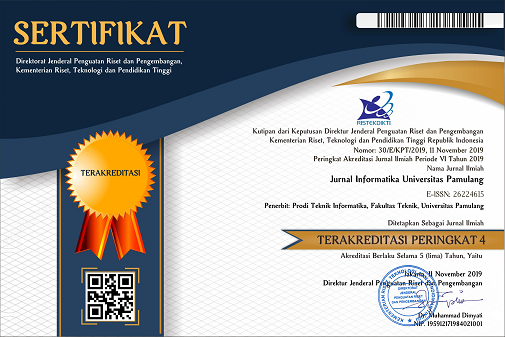Penerapan RFID pada Aplikasi Pembayaran Nontunai Kantin Sekolah (Studi Kasus: Kantin SD Negeri Gunungpuyuh Cipta Bina Mandiri)
DOI:
https://doi.org/10.32493/informatika.v8i1.23205Keywords:
RFID, Web, Cashless, Canteen, Payment instrumentsAbstract
The canteen of SD Negeri Gunungpuyuh Cipta Bina serves students and teachers using a cash payment system. This cash payment creates problems for canteen managers, namely having to be ready with change and payment queues. During the Covid-19 pandemic, canteen managers are required to follow health protocols, one of which is to keep a distance to minimize the spread of the virus. An application is needed by canteen managers to change cash transaction activities into non-cash transactions. The application of RFID (Radio Frequency Identification) technology, as well as Web-based applications, are designed to build a cashless payment system. RFID cards are used for non-cash payment instruments instead of cash. Buyers can use an RFID card as a means of payment for transactions in the canteen and fill in the balance at the canteen manager using a Web-based application. NodeMCU-based RFID ESP 8266 is connected via wifi to the database server. The waterfall method is used to design Web-based applications that function to manage transactions and balances. HTML programming language is used to build applications and MySQL software for databases. The process of making the application starts with assembling the RFID module and testing several RFID cards. Testing the wifi connection and the appearance of the application made shows the test results following the expected results. The process of storing data, managing transactions, and managing buyer balances is well recorded in the created database. This non-cash payment application has been successfully created and is running well, judging by the results of all the tests carried out.
References
Aji, K. P., Darusalam, U., & Nathasia, N. D. (2020). Perancangan Sistem Presensi Untuk Pegawai Dengan RFID Berbasis IoT Menggunakan NodeMCU ESP8266. JOINTECS (Journal of Information Technology and Computer Science), 5(1), 25. https://doi.org/10.31328/jointecs.v5i1.1222
Brown, D. E. (2007). RFID Implementation. McGraww-Hill Publishing.
Desyani, T. (2018). Perancangan Sistem Pembayaran Elektronik Berbasis Radio Frequency Identification (RFID) pada Waserda Koperasi Karyawan PT Multi Karya Usaha. Jurnal Teknologi Sistem Informasi Dan Aplikasi, 1(1), 15. https://doi.org/10.32493/jtsi.v1i1.1948
Fathoroni, A., Fatonah, R. N. S., Andarsyah, R., & Riza, N. (2020). Buku Tutorial Sistem Pendukung Keputusan Penilaian Kinerja Dosen Menggunakan Metode 360 Degree Feedback. Kreatif Industri Nusantara. https://www.google.co.id/books/edition/Memahami_Metode_Omax_dan_Promethee_pada/tIr9DwAAQBAJ?hl=id&gbpv=1&dq=teknik+pengembangan+sistem+waterfall&pg=PA22&printsec=frontcover
Firdaus, M. F., Hanafie, A., & Baco, S. (2021). Rancang Bangun Absensi Siswa Menggunakan RFID Berbasis Arduino Uno. Jurnal Nasional Cosphi, 5(1), 1–6.
Fitri, R. (2020). Pemrograman Basis Data Menggunakan MySQL (Cetakan Pe). POLIBAN PRESS. https://www.google.co.id/books/edition/Pemrograman_Basis_Data_Menggunakan_MySQL/y9kZEAAAQBAJ?hl=id&gbpv=1&dq=basis+data+mysql+adalah&printsec=frontcover
Gidion, R., & Muid, S. A. (2019). Purwarupa Mesin Penjual Beras Otomatis Berbasis Radio Frequency Identification Dengan Antarmuka Website. Coding Jurnal Komputer Dan Aplikasi, 07(03). https://jurnal.untan.ac.id/index.php/jcskommipa/article/view/37173%0Ahttps://jurnal.untan.ac.id/index.php/jcskommipa/article/download/37173/75676583746
Nataliana, D., Hadiatna, F., & Fauzi, A. (2019). Rancang Bangun Sistem Keamanan RFID Tag menggunakan Metode Caesar Cipher pada Sistem Pembayaran Elektronik. ELKOMIKA: Jurnal Teknik Energi Elektrik, Teknik Telekomunikasi, & Teknik Elektronika, 7(3), 427. https://doi.org/10.26760/elkomika.v7i3.427
Oktaviani, R., & Septiana Windyasari, V. (2020). Aplikasi Sistem Parkir Kendaraan Bermotor Menggunakan Teknologi Radio Frequency Identification (RFID) Di Universitas Islam Syekh Yusuf Tangerang. Jimtek, 1(2), 96. http://ejournal.unis.ac.id/index.php/jimtek/article/view/1065
Pramitasari, F. I., & Wahyuni, R. S. (2022). Perancangan dan Pengembangan Produk Kursi Bioskop Menggunakan Metode Quality Function Deployment pada Bioskop. 6(4), 841–848.
Setyawan, M. Y. H., & Munasri, A. S. (2020). Panduan Lengkap Membangun Sistem Monitoring Kinerja Mahasiswa Internship Berbasis Web dan Global System (Cetakan Pe). Kreatif Industri Nusantara. https://www.google.co.id/books/edition/Panduan_Lengkap_Membangun_Sistem_Monitor/wqLzDwAAQBAJ?hl=id&gbpv=1&dq=keunggulan+sistem+berbasis+web&pg=PR10&printsec=frontcover
Suendri. (2021). Buku Ajar Pemrograman Berbasis Web. Penerbit Media Sains Indonesia. https://www.google.co.id/books/edition/Buku_Ajar_Pemrograman_Berbasis_Web/LwhOEAAAQBAJ?hl=id&gbpv=1&dq=bahasa+pemrograman+aplikasi+berbasis+web&printsec=frontcover
Susanto, M. R. P., & Supriyadi, T. (2020). Penggunaan RF-ID Untuk Sistem Pembayaran pada Angkutan Kota Cerdas (Akodas). Prosiding Industrial Research, 26–27. https://jurnal.polban.ac.id/proceeding/article/view/2079%0Ahttps://jurnal.polban.ac.id/ojs-3.1.2/proceeding/article/download/2079/1629
Wahid, A. A. (2020). Analisis Metode Waterfall Untuk Pengembangan Sistem Informasi. Jurnal Ilmu-Ilmu Informatika Dan Manajemen STMIK, November, 1–5.
Yudhanto, Y., & Azis, A. (2019). Pengantar Teknologi Internet of Things (IoT). Penerbitan dan Percetakan UNS (UNS Press). https://www.google.co.id/books/edition/Pengantar_Teknologi_Internet_of_Things_I/lK33DwAAQBAJ?hl=id&gbpv=1
Yurfianto, A. F., & Sumaryanto, S. (2020). Penerapan Teknologi E-Money Untuk Pembayaran Di SPBU. 13(2), 105–117.
Zohrahayaty.dkk. (2019). Karakteristik Penelitian Ilmu Komputer. Penerbit Deepublish. https://www.google.co.id/books/edition/Karakteristik_Penelitian_Ilmu_komputer/qaesDwAAQBAJ?hl=id&gbpv=1&dq=metode+penelitian+sistem+development&pg=PA92&printsec=frontcover
Downloads
Published
Issue
Section
License
Authors who publish with this journal agree to the following terms:
- Authors retain copyright and grant the journal right of first publication with the work simultaneously licensed under a Creative Commons Attribution-NonCommercial 4.0 International (CC BY-NC 4.0) that allows others to share the work with an acknowledgement of the work's authorship and initial publication in this journal.
- Authors are able to enter into separate, additional contractual arrangements for the non-exclusive distribution of the journal's published version of the work (e.g., post it to an institutional repository or publish it in a book), with an acknowledgement of its initial publication in this journal.
- Authors are permitted and encouraged to post their work online (e.g., in institutional repositories or on their website) prior to and during the submission process, as it can lead to productive exchanges, as well as earlier and greater citation of published work (See The Effect of Open Access).
Jurnal Informatika Universitas Pamulang have CC-BY-NC or an equivalent license as the optimal license for the publication, distribution, use, and reuse of scholarly work.
In developing strategy and setting priorities, Jurnal Informatika Universitas Pamulang recognize that free access is better than priced access, libre access is better than free access, and libre under CC-BY-NC or the equivalent is better than libre under more restrictive open licenses. We should achieve what we can when we can. We should not delay achieving free in order to achieve libre, and we should not stop with free when we can achieve libre.
Jurnal Informatika Universitas Pamulang is licensed under a Creative Commons Attribution-NonCommercial 4.0 International (CC BY-NC 4.0)
YOU ARE FREE TO:
- Share : copy and redistribute the material in any medium or format
- Adapt : remix, transform, and build upon the material for any purpose, even commercially.
- The licensor cannot revoke these freedoms as long as you follow the license terms





